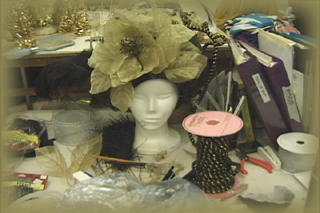
|
A hat-design table in the costume shop. |
A look at the University of Oregon's Costume Design Department
By Brigitta Hawes
Clothing design can claim roots back to prehistoric and Babylonian times. Throughout the ages, however, it has developed into a highly specialized and complex art form.
Its art demands exactness and flexibility, pragmatism and imagination. If executed skillfully, a costume's design can energize and add visual communication to a theatrical production, rendering it both magical and believable. The costume provides an important contribution to the overall impact of a performance.
"In effective costume design, the costume becomes another character in the story and will help to move the story along," said Alexandra Bonds, professor of costume design at the University of Oregon. "Once I attended a performance where the costume design was so unattractive and so inappropriate that I could not
hear what the actors were saying. Conversely, when the costumes work, they achieve a magical quality, a transformative power that helps us to understand what's happening on the stage."
To say that costume design is an automated and organized creative process would be untrue. However, organization is an essential element that must be observed to meet never-ending deadlines. Pattern-drafting, cutting, fitting and sewing are highly technical skills, and must be placed in an order of hierarchy to achieve the desired results. Each step toward the finished design requires a level of expertise all its own.
From fall through spring term, the costume shop at the University of Oregon employs from six to eight students: one to two GTFs, and four or more work-study students majoring in theatre arts. Additionally, newer students from the Theatre Production course TA212, appear often for beginning instruction.

A UO student assistant working on a costume for the
production of "Le Misanthrope."
All of these students are exposed to at least one major Robinson production and one Second Season performance every term. They are able to learn, assist and witness the process from beginning to end. According to Bonds, several steps are necessary to ensure proper and timely completion of a performance's costume design:
♦ The costume designer receives the assignment from the director and begins by researching the script. The time period, fashion styles and perhaps even the playwright will be researched. The latter is necessary if the playwright is from a different time period than the setting of the play. Many factors can play in here, including that of the director's approach to the play. Most often, a combination of research and intuition intermingle to set the style of the costume design.
♦ The costume designer makes preliminary sketches based on the research and meets again with the director.

Bonds reviewing design sketches.
♦ The "feasibility conference" comes next. The student designer will meet with both Bonds and Vicki Vanecek-Young, UO's costume shop manager. Determinations of the feasibility of the designer's projections are made. According to Bonds, "This is Vicki's choice. I mentor in the design aspect, and Vicki coaches in the practical aspect. It is during this meeting that we determine what will need to be bought, borrowed or found in our own stock. What we look at is the budget, the time we have, and the number of people we have to build it. So we need to really look at these three factors."
♦ Based on the outcome of the feasibility conference, the designer continues to develop the designs through rendering and will begin the collection of material swatches. Before the
building process begins, the designer will once more meet with the director.
♦ Vanecek-Young and her student assistants start to develop the patterns through a draping process. Muslin fabric is draped over dress forms, and then a permanent pattern is cut from medium-weight brown paper. The muslin is then pieced and sewn together and tried on the actor for fitting before the more expensive material is cut. Once the fitting is complete, the costumes are then made with the intended fabric.

A design begins to take shape.
♦ In a singsong voice, Bonds mentions the next step: "There is a whole lotta sewin going on." This is a good time, she says, to bring in the newer students.
♦ Two weeks before the show opens, the second fitting is scheduled for the actors in the real fabric. "We check for movement, proportion and line. We set the trims [ornamentation] and establish the hems," says Bonds. It is during the next rehearsal or two that the costumes will go through the real test. "We want the costumes to be done so they can anticipate the patterns of movement so there are no changes," she said. "They need to be comfortable and confident on stage with their costumes."
With the bulk of an audience's appreciation going to directors and actors, the contributions of costume design are often overlooked. There is more than one type of creative magic needed to create an enchanting and credible performance. Though bad design can ruin an otherwise well-acted play, good design can levitate an otherwise standard performance to captivating heights.
|



